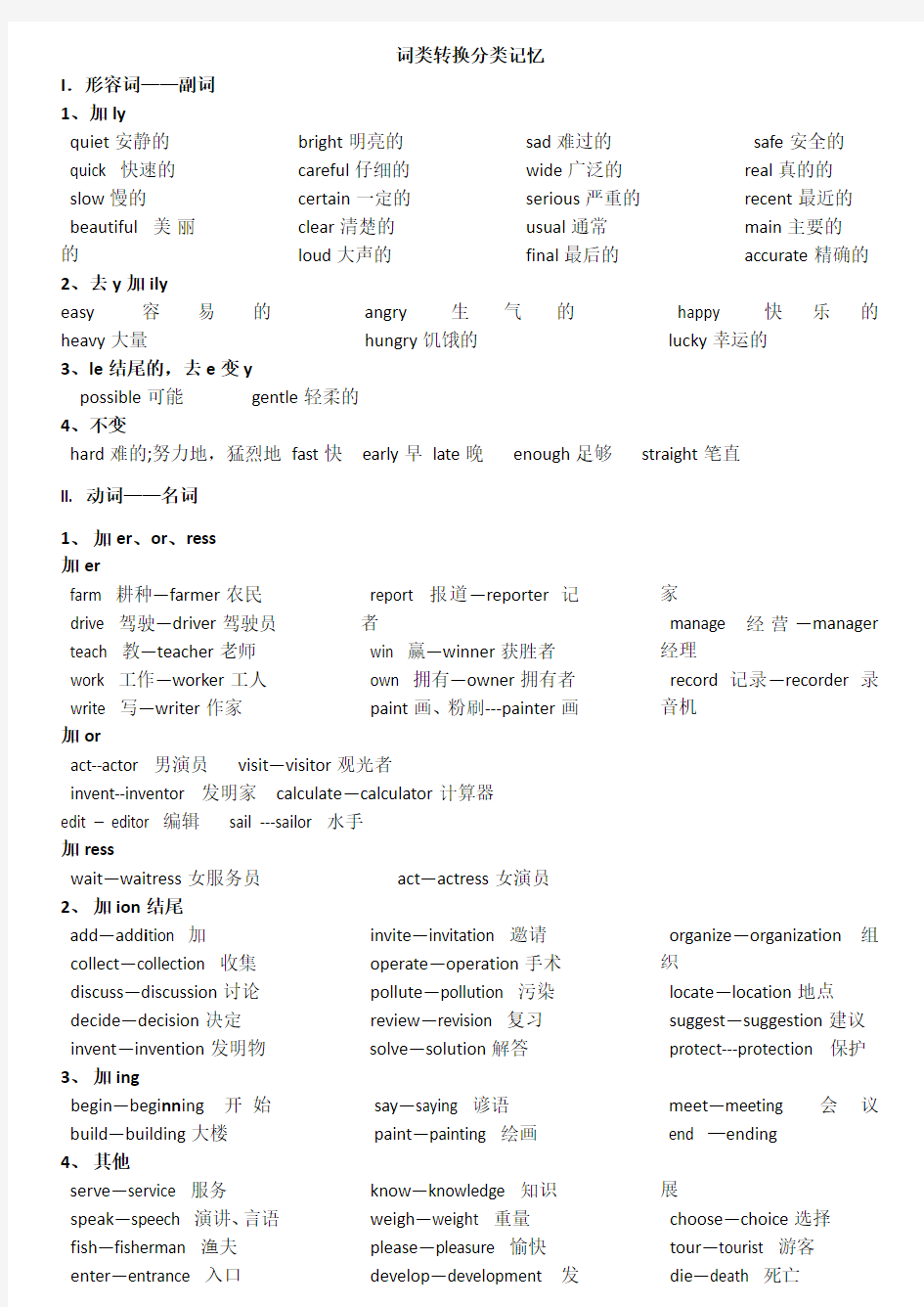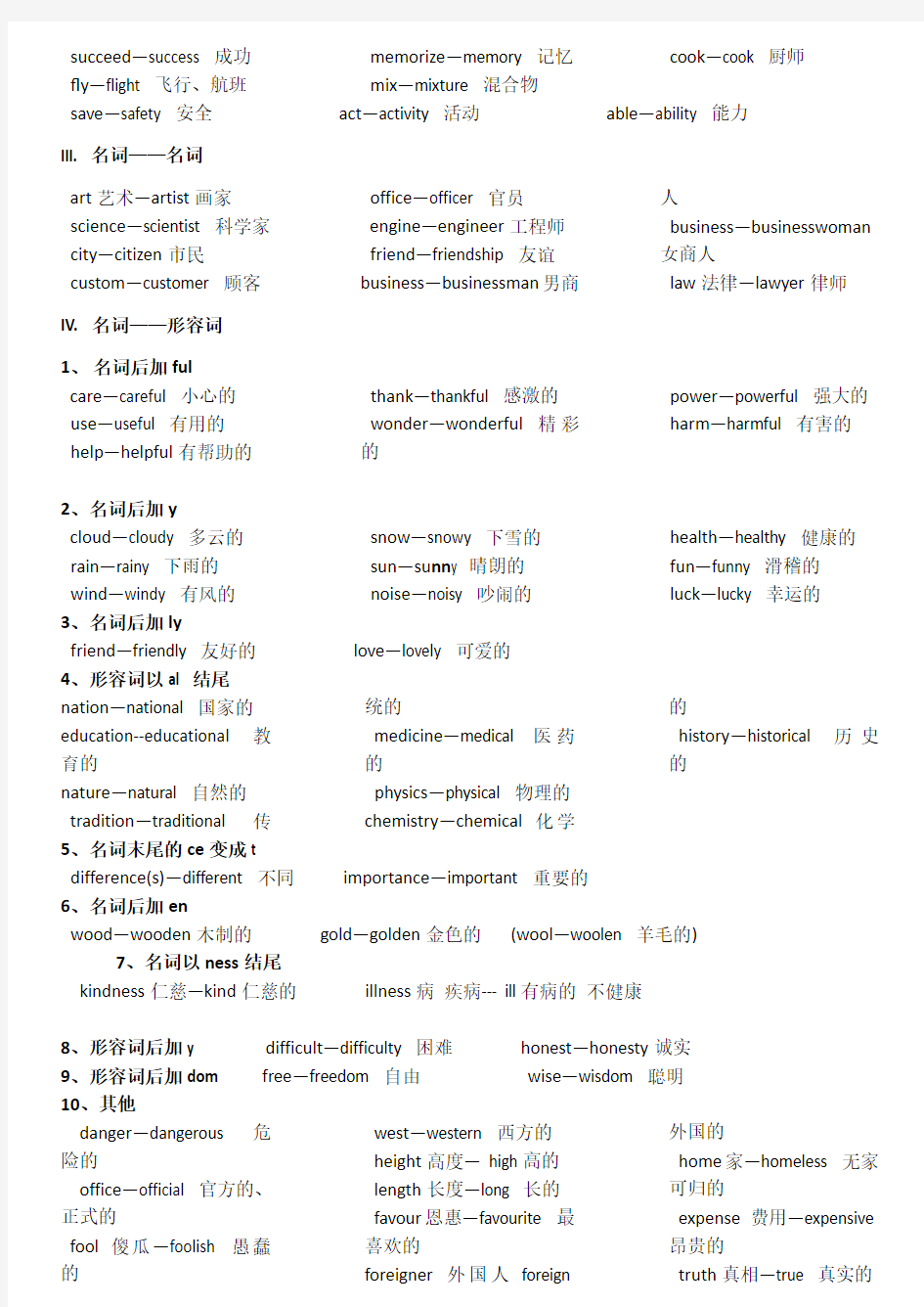

词类转换分类记忆I.形容词——副词
1、加ly
quiet安静的quick 快速的slow慢的beautiful美丽的bright明亮的
careful仔细的
certain一定的
clear清楚的
loud大声的
sad难过的
wide广泛的
serious严重的
usual通常
final最后的
safe安全的
real真的的
recent最近的
main主要的
accurate精确的
2、去y加ily
easy容易的heavy大量angry生气的
hungry饥饿的
happy 快乐的
lucky幸运的
3、le结尾的,去e变y
possible可能gentle轻柔的
4、不变
hard难的;努力地,猛烈地fast快early早late晚enough足够straight笔直II. 动词——名词
1、加er、or、ress
加er
farm 耕种—farmer农民drive 驾驶—driver驾驶员teach 教—teacher老师work 工作—worker工人write 写—writer作家
report 报道—reporter记
者
win 赢—winner获胜者
own 拥有—owner拥有者
paint画、粉刷---painter画
家
manage 经营—manager
经理
record记录—recorder录
音机
加or
act--actor 男演员visit—visitor观光者
invent--inventor 发明家calculate—calculator计算器
edit – editor 编辑sail ---sailor 水手
加ress
wait—waitress女服务员act—actress女演员2、加ion结尾
add—add i tion 加collect—collection 收集discuss—discussion讨论decide—decision决定invent—invention发明物invite—invitation 邀请
operate—operation手术
pollute—pollution 污染
review—revision 复习
solve—solution解答
organize—organization组
织
locate—location地点
suggest—suggestion建议
protect---protection 保护
3、加ing
begin—begi nn ing开始build—building大楼say—saying 谚语
paint—painting 绘画
meet—meeting 会议
end —ending
4、其他
serve—service 服务speak—speech 演讲、言语fish—fisherman 渔夫enter—entrance 入口know—knowledge 知识
weigh—weight 重量
please—pleasure 愉快
develop—development 发
展
choose—choice选择
tour—tourist 游客
die—death 死亡
succeed—success 成功fly—flight 飞行、航班memorize—memory 记忆
mix—mixture 混合物
cook—cook 厨师
save—safety 安全act—activity 活动able—ability 能力III. 名词——名词
art艺术—artist画家science—scientist 科学家city—citizen市民custom—customer 顾客
office—officer 官员
engine—engineer工程师
friend—friendship 友谊
business—businessman男商
人
business—businesswoman
女商人
law法律—lawyer律师
IV. 名词——形容词1、名词后加ful
care—careful 小心的use—useful 有用的help—helpful有帮助的
thank—thankful 感激的
wonder—wonderful精彩
的
power—powerful 强大的
harm—harmful 有害的
2、名词后加y
cloud—cloudy 多云的rain—rainy 下雨的wind—windy 有风的snow—snowy 下雪的
sun—su nn y 晴朗的
noise—noisy 吵闹的
health—healthy 健康的
fun—funny 滑稽的
luck—lucky 幸运的
3、名词后加ly
friend—friendly 友好的love—lovely 可爱的4、形容词以al 结尾
nation—national 国家的education--educational 教育的
nature—natural 自然的tradition—traditional 传统的
medicine—medical 医药
的
physics—physical 物理的
chemistry—chemical化学
的
history—historical 历史
的
5、名词末尾的ce变成t
difference(s)—different 不同importance—important 重要的
6、名词后加en
wood—wooden木制的gold—golden金色的(wool—woolen 羊毛的)
7、名词以ness结尾
kindness仁慈—kind仁慈的illness病疾病--- ill有病的不健康
8、形容词后加y difficult—difficulty 困难honest—honesty诚实
9、形容词后加dom free—freedom 自由wise—wisdom 聪明
10、其他
danger—dangerous 危险的
office—official 官方的、正式的
fool傻瓜—foolish 愚蠢的
west—western 西方的
height高度— high高的
length长度—long 长的
favour恩惠—favourite 最
喜欢的
foreigner外国人foreign
外国的
home家—homeless 无家
可归的
expense费用—expensive
昂贵的
truth真相—true 真实的
wound创伤—wounded 受伤的
pleasure—pleasant 令人愉快的/ pleased 满意的
response相应反映--- responsible 负责的有责任的
electricity电—electric电的—electronic 电子的
V. 动词——形容词
interest引起兴趣—interesting 有趣的/ interested 感兴趣的
excite—exciting 令人激动的/ excited激动的
freeze—freezing 寒冷的/ frozen 冷冻的
frighten—frightening 令人害怕的/ frightened害怕的
forget—forgetful健忘的/ unforgettable 难忘的
depend—independent 独立的有主见的
like—likely很有可能发生的有希望的realize意识到—real 真的
break—broken 碎的follow—following 下面的fill—full 满的、饱的enjoy—enjoyable使人愉快的change—changeable 多变的act—active 积极的attract—attractive 吸引人的die—dead 死的
widen拓宽—wide 宽的live—alive活的
VI. 前缀
possible—impossible (polite, patient)可能—不可能tell—retell说—复述build—rebuild 建造—重建healthy—unhealthy健康的—不健康的honest—dishonest诚实—不诚实的appear—disappear出现—消失like—dislike 喜欢—不喜欢
VII. 国名——国籍
Australia—Australian America—American Canada—Canadian Britain—British England—English Italy—Italian China—Chinese Japan—Japanese
Germany—German (德国人复数German s) \
动词变名词1.v+ ment 结尾 achieve---achievement 成就advertise---advertisement advertising agree— agreement argue---argument争吵announce --- announcement 通知amuse--- amusement 娱乐commit奉献—commitment develop---development disgree—disagreement equip装备---equipment装备,器材govern 统治—government 政府manage---management 经营管理settle--- settlement 定居 2.V+ tion 结尾以t, te, de, 结尾的动词常去E 或直接加ion admit 承认—admission attract吸引—attraction 有吸引力的事或人;令人向往的地方 conclude—conclusion 结论compete—competition竞争,比赛discuss—discussion 讨论educate-----education decide----decision describe—description描写,描绘organize----organization imagine—imagination 想象力introduce—introduction 介绍instruct—instruction 指导,介绍invent—inventor / invention illustrate 阐明,举例说明--illustration invite—invitation inspire---inspiration 灵感,鼓舞人心的pollute----pollution 污染 predict---prediction 预言pronounce ---pronunciation resolve 决心-----resolution 决心impress 给人印象—impression 印象 permit 允许-----permission suggest-建议,暗示--suggestion solve解决-----solution 解决方法 3.V+ ance 结尾 allow—allowance 允许appear—appearance 外貌,出现perform----performance 演出exist—existance 存在 4.V+ ing 结尾 bathe 洗澡---bathing end 结束----ending 结尾,结局train 训练---training mean ---- meaning 意义say-----saying 谚语 5.V+ 其他 beg(乞讨)—beggar 乞丐 sit--seat 座位
词性转换总结与归纳 动词变名词 announce—announcement通知 equip 装备---equipment 装备,器材(不可名) settle—settlement定居,安定 achieve---achievement 成就 amuse--amusement 娱乐 manage---management 经营管理 advertise--- advertisement广告 agree— agreement同意disgree—disagreement不同意 argue---argument争吵commit—commitment奉献 develop---development发展 govern 统治—government 政府 describe—description描写,描绘erupt—eruption爆发 affect—affection影响 satisfy—satisfaction满意,满足select—selection挑选,选择
permit—permission允许admit—admission承认,允许invite—invitation 邀请,请帖devote—devotion献身,专注apply—application申请,申请书produce—production生产,产品protect—protection保护 educate-----education教育consider—consideration考虑attract—attraction 吸引力,吸引instruct—instruction 指导,介绍discuss—discussion 讨论appreciate—appreciation感激,欣赏recognize—recognition认出conclude—conclusion 结论 decide----decision 决定compete—competition比赛 express 表达----expression 词语;表达方式graduate 毕业—graduation operate—operation操作,动手术organize----organization 组织imagine—imagination 想象力
一.形容词变副词规律小结
二.名词复数的变化规律 1、规则变化 1) 一般情况直接在词尾加-s . 如:chair—chairs;apple—apples;grape—grapes; 2)以s、sh、ch、x等结尾的词加–es .如:bus—buses;watch—watches;box—boxes;brush —brushes 3)以辅音字母+y结尾的词,变y 为i 再加es,baby—babies;city—cities;family—families 4)以f或fe结尾的将f或fe直接换成ves. 如:knife—knives;thief—thieves;shelf—shelves 2、不规则变化 1)没有规律的变化。如:child—children;foot—feet;tooth—teeth;mouse—mice; woman—women等。 2)单复同形。如:deer—deer;sheep—sheep;fish—fish;yuan—yuan;tofu—tofu; pork—pork等。 3)以o结尾的名词有的加es有的加s. 如:potato—potatoes;tomato—tomatoes;Hero—heroes 二、动词第三人称单数的变化规则 1)直接在动词后+s. 如:like—likes;play—plays;read—reads;get—gets;help—helps; ski—skis等。 2)以s, x, sh, ch, 接尾的动词:+es. 如:wash—washes;wacth—watches;teach—teaches; brush—brushes等。 3)以辅音+o接尾的动词:+es. 如:go—goes;do—does等。 4)以辅音+y接尾的动词:变y为i+es. 如:fly—flies;study —studies;carry—carries; sky—skies等。 末尾字母y前为元音字母的,直接在动词后面加-s. 如:play—plays;say—says 5)特殊变化。如:be—is;have—has等。这些没有规律,需要加强记忆。 三、动词现在分词-ing形式的构成 1)一般情况在动词原形后加-ing . 如:go—going;stand—standing;climb—climbing等。2)以不发音的e结尾的动词,去掉e,再加-ing. 如:write—writing;hope—hoping;care—caring 3)以-ie结尾的动词应先将e去掉,将i变成y然后再加-ing. 如:die—dying,tie—tying等。4)如果动词最后一音节为重读闭音节,最后一个字母需要重复. 如:run—running; stop—stopping;hop—hopping;plan—planning;star—starring;但辅音x是个例外,无需重复(x其实起着两个辅音的作用)。如:tax—taxing,relax—relaxing等。 5)以-ee,-oe,-ye结尾的动词加-ing时应保留词尾e. 如:see—seeing;hoe—hoeing;eye—eyeing 6)-ic结尾的动词应先在字母c后加一字母k再加-ing. 如:panic—panicking; picnic—picnicking 三.动词变名词小结 1.在词尾加er,r ,双写加er 或or: A. play _ player, sing _ singer, wait _ waiter , find _ finder, thrill _ thriller
常见词形变化动词变名词 1.v+ ment 结尾 achieve---achievement 成就advertise--- advertisement// advertising agree— agreement appoint----appointment disappoint----disappointment disagree --- disagreement amuse----amusement 娱乐 argue---argument争吵commit—commitment奉献develop---development equip ---equipment 装备,器材govern 统治—government 政府manage---management 经营管理 2.V+ tion/sion 结尾 admit—admission承认attract—attraction 有吸引力的事或人; conclude—conclusion 结论compete—competition 竞争,比赛consider---consideration discuss—discussion 讨论 decide----decision describe—description描写,描绘direct---direction determine---determination educate-----education explain----explanation express ----expression graduate—graduation hesitate---hesitation invite—invitation imagine—imagination 想象力introduce—introduction 介绍instruct—instruction 指导,介绍invent—inventor / invention illustrate --illustration inspire---inspiration 灵感,鼓舞 人心的 impress—impression operate—operation organize----organization permit---permission pollute----pollution predict---prediction prepare---preparation pronounce ---pronunciation resolve -----resolution 决心 suggest --suggestion solve -----solution satisfy----satisfaction 3.V+ ance /ence结尾 allow—allowance 允许appear—appearance 外貌,出现disappear---disappearance 消失perform----performance --performer exist—existence 存在 4.V+ ing 结尾 bathe 洗澡---bathing end 结束----ending 结尾,结局train 训练---training mean ---- meaning 意义say-----saying 谚语 5.V+ 其他 able---ability---disable assist----assisitant analyze---analysis arrive-- arrival到达 beg(乞讨)—beggar 乞丐believe—belief 信仰 behave ----behavior die---dead----death employ--employer雇主--employee雇员 know---knowledge
打印英语单词词性转换 的基本规律 Document serial number【NL89WT-NY98YT-NC8CB-NNUUT-NUT108】
英语单词词性转换的基本规律 动词(v.)→名词(n.) (a)词形不变,词性改变 例如:work,study,water,plant等可以用作动词(工作,学习,浇水,种植),也可以用作名词(工作,学习,水,植物). (b)一些动词在词尾加上-er或-or之后就变成了表示"某一类人"的名词 例如:work—worker,teach—teacher,sing—singer, jump—jumper,play—player,learn—learner, visit—visitor,invent—inventor, collect—collector等. 注意:1)以不发音的e结尾的动词,在词尾加-r. 例如:drive—driver,write—writer等. 2)以重读闭音节结尾,且末尾只有一个辅音字母的动词,应双写末尾的辅音字母,再加-er 例如:run—runner,win—winner,begin—beginner 等. (c)在动词词尾加上-ment变成名词 例如:achieve—achievement(成就) advertise—advertisement//advertising(广告) agree—agreement disgree—disagreement amuse—amusement(娱乐) improve—improvement(争吵) commit(奉献)—commitment develop—development(发展) depart—department(局,部) govern(统治)—government(政府) manage—management(管理) equip—equipment(装备) 有些单词比较特殊,需把动词后的e去掉再加ment.例如:argue—argument(争论) (d)在动词词尾加上-(t)ion/(s)ion变成名词 例如:attract—attraction;instruct—instruction; invent—inventiondiscuss—discussion; express—expressioneducate—education; graduate—graduation;operate— operation(去e再加"ion") compete—competition;organize— organization(把e改成其他字母再加"tion")decide—decisionconclude—conclusion(把de改 为s再加"ion") describe—description描写,描绘(这是特例,不规则变化) (e)在动词词尾加上-ance变成名词 例如:appear—appearance(外貌;出现) perform—performance(演出) accept—acceptance(接受) (f)在动词词尾加-ing变成名词(方法与动词变为现在分词的方法相同) 例如:meet—meetingbuild—buildingwait— waiting bathe—bathingsay—saying(谚语)mean—meaning end—endingtrain—trainingwash—washing 注意:以重读闭音节结尾,且末尾只有一个辅音字母 的动词,应双写末尾的辅音字母,再加-ing 如:swim—swimmingshop—shoppingbegin—beginning (g)其他一些比较特殊的变化 例如:Beg(乞讨)—beggar(乞丐)behave(行为举止)—behavior know(知道)—knowledge(知识)fly—flight(飞行) heat(加热)—heat(热量)hit(撞击)—hit(轰动一时的人或物,碰撞) mix(混合)—mixture(混合物)press(按,压)—pressure(压力) sit(坐)—seat(座位)succeed—success(成功) tour—tour(旅游)/tourist(游客) 2.动词(v.)→形容词(adj.) (a)动词后面加able,以e结尾的动词则去e加able,表示具有此性质,特点或属性. 例如:afford-affordable;love-lovable (b)动词后面加ed,以e结尾的动词则直接加d,表示被动性的属性或特点. 例如:scatter-scattereduse-used (c)不规则的动词则必须记忆,记住其过去分词形式.规律不大,意义同(b). 3.名词(n.)→形容词(adj.) (a)在名词后面加-y可以变成形容词(尤其是一些与天气有关的名词) 例如:rain—rainy,cloud—cloudy,wind— windy,snow—snowy,health—healthy,luck—lucky,anger—angry guilt—guilty(内疚的)tourist—touristy(游客多的), salt(盐)—salty(咸的)
英语单词词性转换的基本规律 (1.动词(v.)→名词(n.) (a)词形不变,词性改变 例如:work, study, water, plant等可以用作动词(工作,学习,浇水,种植),也可以用作名词(工作,学习,水,植物). (b)一些动词在词尾加上-er或-or之后就变成了表示"某一类人"的名词 例如:work—worker, teach—teacher, sing—singer, jump—jumper, play—player, learn—learner, visit—visitor, invent—inventor, collect—collector等. 注意:1)以不发音的e结尾的动词,在词尾加-r. 例如:drive—driver, write—writer等. 2)以重读闭音节结尾,且末尾只有一个辅音字母的动词,应双写末尾的辅音字母,再加-er 例如:run—runner, win—winner, begin—beginner等. (c)在动词词尾加上-ment 变成名词 例如:achieve—achievement (成就) advertise—advertisement//advertising(广告) agree—agreement disgree—disagreement amuse—amusement (娱乐) improve—improvement(争吵) commit(奉献)—commitment develop—development (发展) depart—department (局,部) govern(统治)—government(政府) manage—management (管理) equip—equipment (装备) 有些单词比较特殊,需把动词后的e去掉再加ment. 例如:argue—argument(争论)
常见上海中考词性转换汇总 注:供大家中考复习时参考,其中带*为2018新增词汇(汇总词汇中个别单词可能与2018考纲有差异,特此说明。) _________ v.使…能够,使… 有能 力的 _________ adj. 能够;有能力的 n. 能力;才能 ____________ prep. 穿过;横过 v. 穿越/ n. 十字,叉 ___________ n. 行动;扮演 _________ a. 积极的 _____________ n. 活动 ___________ n. 男演员 __________ n. 女演员 _________ v. 增加 _______________ n. 增加 _____________ n. 优点,优势,有利条件 _______________ n. 不利,劣势,短处 __________ n. 年龄 a. 年老的 __________ a. 活着的;活泼的
___________ v. 居住;生活 (lives复数)n. 生活;生命 ___________ v. 使消遣,娱乐 _____________ adj.引起乐趣的 n. 娱乐,消遣,娱乐活动____________ a. 生气的 ad. 生气地 _________ n. 艺术 n. 艺术家 _____________ n. 澳大利亚 a./n.澳大利亚的/人 ___________ v. 出现 v. 消失 ______________v. 吸引 _______________ n. 吸引,吸引力,吸引物______________a. 有吸引人的 __________ n. 根据地,基地,基础 _____________ adj. 基本的,基础的 _________________ a. 漂亮的 _________________ ad. 美丽地 ___________(began, begun) v. 开始 __________________ n. 开始,开端 ___________ adj. 感到乏味的,厌倦的
英语单词词性转变的一般规律 1.动词(v.)→名词(n.) (a)词形不变,词性改变 例如:work, study, water, plant等可以用作动词(工作,学习,浇水,种植),也可以用作名词(工作,学习,水,植物). (b)一些动词在词尾加上-er或-or之后就变成了表示"某一类人"的名词 例如:work—worker, teach—teacher, sing—singer, jump—jumper, play—player, learn—learner, visit—visitor, invent—inventor, collect—collector等. 注意:1)以不发音的e结尾的动词,在词尾加-r. 例如:drive—driver, write—writer等. 2)以重读闭音节结尾,且末尾只有一个辅音字母的动词,应双写末尾的辅音字母,再加-er 例如:run—runner, win—winner, begin—beginner等. (c)在动词词尾加上-ment 变成名词 例如:achieve—achievement (成就) advertise—advertisement//advertising(广告) agree—agreement disagree—disagreement amuse—amusement (娱乐) improve—improvement(争吵) commit(奉献)—commitment develop—development (发展) depart离开;出发,起程;违反;去世—department (局,部) govern(统治)—government(政府) manage—management (管理) equip—equipment (装备) 有些单词比较特殊,需把动词后的e去掉再加ment. 例如:argue—argument(争论) (d)在动词词尾加上-(t)ion/(s)ion变成名词 例如: attract—attraction; instruct—instruction; invent—invention discuss—discussion; express—expression educate—education; graduate—graduation; operate—operation (去e再加"ion") compete—competition; organize—organization (把e改成其他字母再加"tion") decide—decision conclude—conclusion (把de改为s再加"ion") describe—description描写,描绘 (这是特例,不规则变化) (e)在动词词尾加上-ance变成名词 例如: appear—appearance (外貌;出现) perform—performance (演出) accept—acceptance (接受) (f)在动词词尾加-ing变成名词 (方法与动词变为现在分词的方法相同) 例如:meet—meeting build—building wait—waiting bathe—bathing say—saying(谚语) mean—meaning
英语单词词性转换的基本规律 一词性变换的一般的规律 1.动词(v.)→名词(n.) (a)词形不变,词性改变work, study, water, plant等可以用作动词(工作,学习,浇水,种植),也可以用作名词(工作,学习,水,植物). (b)一些动词在词尾加上-er或-or之后就变成了表示"某一类人"的名词 例如:work—worker, teach—teacher, sing—singer, jump—jumper, play—player, learn—learner, visit—visitor, invent—inventor,collect—collector等. 注意:1)以不发音的e结尾的动词,在词尾加-r. 例如:drive—driver, write—writer等. 2)以重读闭音节结尾,且末尾只有一个辅音字母的动词,应双写末尾的辅音字母,再加-er例如:run—runner, win—winner,begin—beginner等. (c)在动词词尾加上-ment 变成名词 例如:achieve—achievement (成就) advertise—advertisement(广告) agree—agreement disagree—disagreement amuse—amusement (娱乐) improve—improvement(争吵) commit(奉献)—commitment develop—development (发展) depart—department (局,部) govern(统治)—government(政府) manage—management (管理) equip—equipment (装备) 有些单词比较特殊,需把动词后的e去掉再加ment.例如:argue—argument(争论) (d)在动词词尾加上-(t)ion/(s)ion变成名词 例如: attract—attraction; instruct—instruction; invent—invention discuss—discussion; express—expression educate—education; graduate—graduation; operate—operation (去e再加"ion") compete—competition; organize—organization (把e改成其他字母再加"tion") decide—decision conclude—conclusion (把de改为s再加"ion") describe—description描写,描绘(这是特例,不规则变化) (e)在动词词尾加上-ance变成名词 例如: appear—appearance (外貌;出现) perform—performance (演出) accept—acceptance (接受) (f)在动词词尾加-ing变成名词(方法与动词变为现在分词的方法相同) 例如: meet—meeting build—building wait—waiting bathe—bathing say—saying(谚语) mean—meaning end —ending train —training wash—washing 注意:以重读闭音节结尾,且末尾只有一个辅音字母的动词,应双写末尾的辅音字母,再加-ing
词类转换分类记忆I.形容词——副词 1、加ly quiet安静的quick 快速的slow慢的beautiful美丽的bright明亮的careful仔细的certain一定clear清楚 loud大声 sad难过的 wide广泛 serious严重的 usual通常 final最后 safe安全 real真的 recent最近的 main主要 accurate精确的 2、去y加ily easy容易的heavy大量angry生气的hungry饥饿的happy 快乐的lucky幸运的3、le结尾的,去e变y possible可能gentle轻柔的4、不变 hard难的;努力地,猛烈地fast 快 early早late 晚enough足够straight笔直II. 动词——名词 1、加er、or、ress 加er farm 耕种—农民 drive 驾驶—驾驶员司机teach 教—老师work 工作—工人
write 写—作家 report 报道—记者 win 赢(winner)—获胜者own 拥有—owner拥有者paint画、粉刷---画家manage 经营—经理record 记录—录音机 加or act--actor 男演员 visit—visitor观光者 invent--inventor 发明家 calculate—calculator计算器 加ress wait—waitress女服务员act—actress女演员2、加ion结尾 add—add i tion 加collect—collection 收集discuss—discussion讨论decide—decision决定invent—invention发明物invite—invitation 邀请operate—operation手术pollute—pollution 污染review—revision 复习solve—solution解答organize—organization组织locate—location地点suggest—suggestion建议protect---prote ction 保护 3、加ing begin—begi nn ing开始build—building大楼say—saying 谚语paint—painting 绘画
动词变名词 + ment 结尾 achieve---achievement 成就advertise--- advertisement词+ ed balance –balanced 平衡的 spot 斑点,地点----spotted 有斑点的talent-----talented 有天赋的organized 有组织的 distusted 厌恶的offended 生气的crowded 拥挤的polluted 被污染的pleased 高兴的 3.名词+ ful/less meaning—meaningful 有意义的care—careful/ careless 小心的;粗心的 help---helpful / helpless home—homeless 无家可归的 colour---colourful pain 疼痛---painful 痛苦的 use---useless/ useful thank—thankful 充满感激的 peace 和平---- peaceful 平静的,宁静的 playful 顽皮的,爱玩耍的 4.名词+ able adjustable 可调整的comfort---comfortable knowledge---knowledgeable suit 一套-----suitable 合适的 5.名词+ ous courage—courageous 勇敢的danger—dangerous mystery 神秘-----mysterious 神秘的变t confidence----confident difference---different dependence—dependent independence--independent 7. al 结尾 Addition—additional 附加的,额外的Class—classical 经典的 medicine 药----medical 医学的music---musical nature---natural 自然的 person---personal (私人的)nation—national 国家的 education---educational有教育意义的tradition----traditional 传统的 origin起源---original 新颖的;独创的grammar—grammatical 语法的globe—global 全球的 8.名词+ ly friend—friendly live---lively 活跃的,有生气的love—lovely 可爱的9.+ en 结尾wood—wooden 木制的wool—woolen 羊毛的 10. 其他 energy精力---energetic strategy—strategic 战略的 fool 傻子—foolish 愚蠢的freedom 自由—free 空的,免费的height 高度—high illness 疾病--- ill love—loving 慈爱的 death---dead pleasure---pleasant / pleased popularity 流行性—popular
动词变名词1.v+ment结尾 achieve---achievement成就advertise---advertisementadvertisi ng agree—agreement argue---argument争吵announce---announcement通知amuse---amusement娱乐commit奉献—commitment develop---development disgree—disagreement equip装备---equipment装备,器材govern统治—government政府manage---management经营管理settle---settlement定居 2.V+tion结尾以t,te,de,结尾的动词常去E或直接加ion admit承认—admission attract吸引—attraction有吸引力的事或人;令人向往的地方 conclude—conclusion结论compete—competition竞争,比赛discuss—discussion讨论educate-----education decide----decision describe—description描写,描绘organize----organization imagine—imagination想象力introduce—introduction介绍instruct—instruction指导,介绍invent—inventor/invention illustrate阐明,举例说明 --illustration invite—invitation inspire---inspiration灵感,鼓舞人心的pollute----pollution污染 predict---prediction预言pronounce---pronunciation resolve决心-----resolution决心impress给人印象—impression印象 permit允许-----permission suggest-建议,暗示--suggestion solve解决-----solution解决方法 3.V+ance结尾 allow—allowance允许appear—appearance外貌,出现perform----performance演出exist—existance存在 4.V+ing结尾 bathe洗澡---bathing end结束----ending结尾,结局train训练---training mean----meaning意义say-----saying谚语
初中英语词性转换常见词汇
动词变名词1.v+ ment 结尾 achieve---achievement 成就advertise--- advertisement// advertising agree— agreement apartment 公寓 amusement 娱乐 argue---argument争吵 commit奉献—commitment compliment 称赞,恭维 develop---development disgree—disagreement department 局,部 experiment 实验,试验 equip 装备---equipment 装备,器材govern 统治—government 政府manage---management 经营管理 2.V+ tion 结尾 admit 承认—admission attract吸引—attraction 有吸引力的事或人;令人向往的地方 conclude—conclusion 结论compete—competition 竞争,比赛discuss—discussion 讨论 educate-----education decide----decision describe—description描写,描绘express 表达----expression 词语;表达方式 graduate 毕业—graduation operate 操作,动手术—operation organize----organization imagine—imagination 想象力introduce—introduction 介绍instruct—instruction 指导,介绍invent—inventor / invention illustrate 阐明,举例说明--illustration invite—invitation inspire---inspiration 灵感,鼓舞人心的--- pollute----pollution 污染 predict---prediction 预言 pronounce ---pronunciation resolve 决心-----resolution 决心impress 给人印象—impression 印象permit 允许-----permission suggest-建议,暗示--suggestion solve解决-----solution 解决方法 3.V+ ance 结尾 allow—allowance 允许appear—appearance 外貌,出现perform----performance 演出exist—existance 存在 4.V+ ing 结尾 bathe 洗澡---bathing end 结束----ending 结尾,结局train 训练---training mean ---- meaning 意义say-----saying 谚语 5.V+ 其他 Beg(乞讨)—beggar 乞丐sit--seat 座位employ--employer 雇主,老板--employee雇员 believe—belief 信仰 behave 行为,举止----behavior know---knowledge fly—flight 飞行 heat 加热---heat 热量 hit 撞击------hit 轰动一时的人或物,碰撞 mix 混合-----mixture 混合物press 按,压—pressure 压力receive—receptionist 接待员serve—service 服务 succeed-- success tour 在-----旅游,在-----作巡回演出直接+地点tour China ---tour 旅游/ tourist 游客 pursue—pursuit 追求,从事
英语单词词性转换的基本规律 .动词(v.)→名词(n.) (a)词形不变,词性改变 例如:work, study, water, plant等可以用作动词(工作,学习,浇水,种植),也可以用作名词(工作,学习,水,植物). (b)一些动词在词尾加上-er或-or之后就变成了表示"某一类人"的名词 例如:work—worker, teach—teacher, sing—singer, jump—jumper, play—player, learn—learner, visit—visitor, invent—inventor, collect—collector等. 注意:1)以不发音的e结尾的动词,在词尾加-r. 例如:drive—driver, write—writer等. 2)以重读闭音节结尾,且末尾只有一个辅音字母的动词,应双写末尾的辅音字母,再加-er 例如:run—runner, win—winner, begin—beginner(新手,初学者)等. (c)在动词词尾加上-ment 变成名词 例如:achieve—achievement (成就) advertise—advertisement//advertising(广告) (同意) agree—agreement(协议) disagree—disagreement amuse—amusement (娱乐) improve—improvement(争吵) commit(奉献)—commitment develop—development (发展) (离开,出发)depart—department (局,部) govern(统治)—government(政府)
英语词性转换规则大全 (1).动词转化为名词, post-postage mail-mail weigh-weight advise-advice (2)动词转化成名词-形容词 act-actor / actress-active change-change-changeable (3) 动词转化成形容词,副词,名词 fill-full need-necessary-necessarily interest(v. / n.) interested /interesting (4)n. a. n. a.名词转化为形容词 person personal ( 个人的; 私人的 ) fun funny (5)n. pl. n. pl.名词转化为名词复数 gentleman gentlemen human humans (6)a. ad. a. ad.形容词转化为副词 possible possibly probable probably (7)a. ad. n.形容词转化为副词,名词 true truly truth lucky luckily luck (8)原级比较级最高级 far farther / further farthest / furthest little less least 一、名词变为形容词的方法 1. 在名词后面加-y可以变成形容词(尤其是一些与天气有关的名词)。例如:rain—rainy, cloud—cloudy, wind—windy, snow—snowy, health—healthy, luck—lucky等。 注意:1)如果名词以重读闭音节结尾,且词尾只有一个辅音字母,这时应双写词尾的辅音字母再加-y。如:sun—sunny, fun—funny等。 2)少数以不发音的e结尾的名词变为形容词时,应去掉e再加-y。例如:noise—noisy, ice—icy 等。